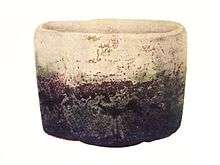Mishima ware

Mishima ware is a slip inlay style of Japanese pottery adopted from Korea, likely in the 16th century.
Nomenclature
The name Mishima might have been coined in the 17th century, but the style itself goes back to Goryeo (935-1392) when bowls decorated in this way were known as Korai-jawan or Korai tea bowls. It is also known as gohon,[1] and originated from Buncheong pottery.
Korean Mishima is not to be confused with the same name that is used in the treatise Tōkikō, which describes shimamono from southeast Asia.[2]
Characteristics and creation
In Mishima ware, bowls were inlaid with various motifs such as floral and animal depictions.
To create these motifs, a potter would begin by engraving the design in the body. Next, the engravings would be filled with contrasting colored clay (or slip). Finally, the bowl is then covered it with a transparent glaze.
This technique peaked in Korea during the 12th and 13th-century Koryo celadons, deemed "first under heaven." It is also referred to as zogan.
Another inlay style is called reverse inlay. With this technique, the potter cuts away the background, leaving the design in relief. Then, with the design established, the background is brushed over with a slip. Finally, the excess is scraped away.
References
- ↑ Laufer, Berthold (1976-01-01). Kleinere Schriften: Publikationen aus der Zeit von 1911 bis 1925. 2 v. Otto Harrassowitz Verlag. ISBN 9783515026512.
- ↑ Laufer, Berthold (1976-01-01). Kleinere Schriften: Publikationen aus der Zeit von 1911 bis 1925. 2 v. Otto Harrassowitz Verlag. ISBN 9783515026512.
External links
![]() Media related to Mishima ware at Wikimedia Commons
Media related to Mishima ware at Wikimedia Commons
- The Mystery and the Mastery by Robert Yellin, The Japan Times, Oct 10, 2001.
- [1]
- http://pottery.about.com/od/slipsengobes/ss/mishima.htm#showall
- http://www.japantimes.co.jp/culture/2001/10/10/arts/the-mystery-and-the-mastery/
- ↑ "MISHIMA Menu - EY Net Japanese Pottery Primer". www.e-yakimono.net. Retrieved 8 November 2016.
